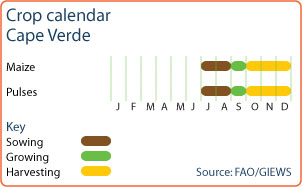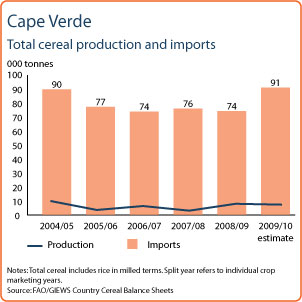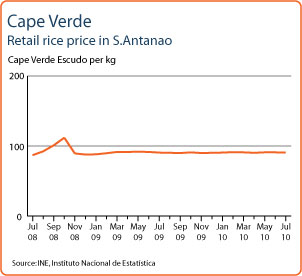Cape Verde: Cape Verde Agriculture Profile 2012
2012/02/28
Cape Verde Agriculture Profile 2012
|
FOOD SECURITY SNAPSHOT
|
Seasonably dry conditions prevail
The rainy season has not started yet. Planting of maize normally starts in July with the onset of the rains on the main islands.
An above average crop was gathered in 2010
Harvesting of maize – the only cereal grown in the country – was completed in December. The 2010 production was estimated at 7 383 tonnes mostly produced in Santiago Island (57 percent) and Fogo Island (24 percent). This level of output is 5 percent below the 2009 harvest but 23 percent above average.
Food security is constrained by high food prices and reduced allocations of food aid
Cape Verde is highly dependent on cereal imports, especially for rice and wheat, which are not grown in the country. Approximately 80 percent of the national cereal requirements are imported.
Until recently, food aid played a major role in Cape Verde’s food policy, accounting for over 50 percent of total cereal consumption in some years. Monetisation of food aid in the form of “cash-for-work” activities has been the main instrument used by the Government to deal with food emergencies. However, the amount of food aid received has declined sharply in recent years due to various factors, including the upgrading of Cape Verde to medium-developed country status from least-developed country, and the shift of several donors’ aid policy to direct budget support. For example, the country received only about 7 000 tonnes of food aid per year over 2006-2010 compared to an average of 37 000 tonnes between 2002 and 2005
Moreover, the price of rice, the main imported cereal, has been increasing steadily since 2007. In April 2011 the price of rice was about 63 percent higher compared to April 2008. The recent sharp rise in international food prices, notably of wheat, maize, sugar and oils, is likely to lead to higher inflationary pressure on the domestic food market. The food situation in the remainder of the 2010/11 marketing year (November/October) will depend on the evolution of international food prices and actions the Government may take to mitigate their impact on consumers’ purchasing power.
|
FOOD SECURITY SNAPSHOT
|
An above average crop was gathered in 2010
Harvesting of maize – the only cereal grown in the country – was completed in December. A CILSS Crop Assessment Mission, which visited the country last October, estimated the 2010 production at 7 383 tonnes mostly produced in Santiago Island (57 percent) and Fogo Island (24 percent). This level of output is 5 percent below the 2009 harvest but 23 percent above average.
Food security is constrained by high prices and reduced allocations of food aid
Cape-Verde is highly dependent on cereal imports, especially for rice and wheat, which are not grown in the country. Approximately 80 percent of the national cereal requirements are satisfied by imports.
Until recently, food aid played a major role in Cape Verde’s food policy, accounting for over 50 percent of total cereal consumption in some years. Monetisation of food aid in the form of “cash-for-work” activities has been the main instrument used by the Government to deal with food emergencies. However, the amount of food aid received has declined sharply in recent years due to various factors, including the upgrading of Cape Verde to medium-developed country status from least-developed country, and the shift of several donors’ aid policy to direct budget support. For example, the country received only about 7 000 tonnes of food aid per year over 2006-2010 compared to an average of 37 000 tonnes between 2002 and 2005.
Moreover, the price of rice, the most imported cereal, has been increasing steadily since 2007, and in November 2010 prices were about 53 percent higher compared to November 2007. The recent sharp rise in international food prices, notably of wheat, maize, sugar and oils, is likely to lead to higher inflationist pressure on the domestic food market. The food situation during the 2010/11 marketing year will depend on the evolution of international food prices and actions the Government may take to mitigate their impact on consumers’ purchasing power.
03/12/2010 Insufficient rainfall contributed to a decline in maize production in 2009
 Planting of the 2010 maize crop – the only cereal grown in the country – and pulses, is scheduled to finish at the end of August. Maize production is concentrated in the two islands of Santiago Island (55 percent) and Fogo Island (28 percent).
Planting of the 2010 maize crop – the only cereal grown in the country – and pulses, is scheduled to finish at the end of August. Maize production is concentrated in the two islands of Santiago Island (55 percent) and Fogo Island (28 percent).
The 2009 maize crop, harvested between October and December last year, was estimated at 7 383 tonnes, representing an 8 percent decline compared to the previous season; however, production levels are still slightly above the average. The drop in production was due to inadequate rainfall during the cropping season.
Rice prices remain stable
 Rice prices, the most important food staple, increased steadily since 2007. However, price levels in Santo Antanao have remained very stable since November 2008.
Rice prices, the most important food staple, increased steadily since 2007. However, price levels in Santo Antanao have remained very stable since November 2008.
The country is highly dependent on cereal imports, especially for rice and wheat, which are not grown in the country. Approximately 80 percent of the national cereal requirements are satisfied by imports. Despite the decrease in international prices since 2008, for both wheat and rice, wheat prices, in particular, have risen by 25 percent between July and August 2010, and this could have a bearing on the country’s import capacity.
Decline in provision of food assistance
 The amount of food aid received has declined sharply in recent years due to various factors, including the upgrading of Cape Verde to medium-developed country status from least-developed country in January 2008, and the shift of several donors’ aid policy to direct budget support. The country received only about 7 000 tonnes of food aid per year over 2006-2009 compared to an average of 37 000 tonnes between 2002 and 2005. As part of this shift, WFP’s direct school feeding programme was scheduled for termination in July 2010, following a gradual phase-out from the beginning of 2007. WFP is now supporting the Government to continue to provide school feeding assistance.
The amount of food aid received has declined sharply in recent years due to various factors, including the upgrading of Cape Verde to medium-developed country status from least-developed country in January 2008, and the shift of several donors’ aid policy to direct budget support. The country received only about 7 000 tonnes of food aid per year over 2006-2009 compared to an average of 37 000 tonnes between 2002 and 2005. As part of this shift, WFP’s direct school feeding programme was scheduled for termination in July 2010, following a gradual phase-out from the beginning of 2007. WFP is now supporting the Government to continue to provide school feeding assistance.
Agriculture in Cape Verde is an industry that has plenty of potential.
 Crops
Crops
The most common agricultural activity of the Cape Verde islands is gardening for domestic utilization. Garden crops consist of corn, cassava, sweet potatoes, and bananas. Just 11.2% of the land area is appropriate for crop production. Common droughts often exacerbate an ongoing water shortage. Agriculture employed about 21% of the active population and contributed 15 percent to GDP in 2003. Estimated 2004 production figures were sugarcane, 14,000 tons; corn, 14,000 tons; bananas, 6,000 tons; coconuts, 5,000 tons; mangoes, 4,500 tons; cassava, 3,000 tons; and potatoes, 3,500 tons. Only the islands of São Tiago, São Vicente, São Nicolau, and Santo Antão have conditions suitable for raising cash crops. Bananas, the only agricultural export, are grown on irrigated land. Sugarcane, another cash crop, is used on the islands to produce rum.
Development
Agriculture has been the focus of development aid programs since the 1960s, but progress has  been frustrated by drought, locusts, overgrazing, and archaic cultivation methods. Approximately 85–90 percent of food needs are met by imports; agricultural imports had a value of $112.8 million in 2004.
been frustrated by drought, locusts, overgrazing, and archaic cultivation methods. Approximately 85–90 percent of food needs are met by imports; agricultural imports had a value of $112.8 million in 2004.
Land reform
The African Party for the Independence of Guinea and Cape Verde (PAIGC) nationalized a few large-scale irrigated agricultural operations and began a program of land reform and cooperative agriculture; sharecropping was abolished. During 1976–80, 7,200 rainwater dikes were built. Torrential rains in 1984 destroyed much of this work, but by 1986, 17,000 dikes and 25,000 stone retaining walls had been completed. There has been little land redistribution, despite a 1982 law distributing farms over five hectares (12.5 acres)—1 hectare (2.5 acres) if irrigated—among the tenants if the land is not directly farmed by the owners.
- Cape Verde News
-
- CHINA: Macau businessman wants to take companies from China to Cabo Verde
- BOTSWANA: Routes Africa forum aims to improve African air connectivity
- BOTSWANA: Economic integration is helping boost trade and investment in Africa
- BOTSWANA: Africa’s economic growth is likely to be slower in the intervening years
- BOTSWANA: Beyond Commodities: How African Multinationals Are Transforming
- CAPE VERDE: Standard & Poor’s said Cabo Verde’s reputation as one of the most stable countries in Africa
- Trending Articles
-
- KENYA: Kenya's tea industry moves toward strategic diversification
- CHINA: Forty-six Chinese-owned companies registered in Guinea-Bissau
- GHANA: Ghana steps up to secure electricity supply
- TUNISIA: Tunisia augments ICT exports and connectivity
- INDIA: Indian central bank chief to step down in surprise move
- NIGERIA: Nigeria’s e-commerce industry shows growth potential






.gif?1356023993)


